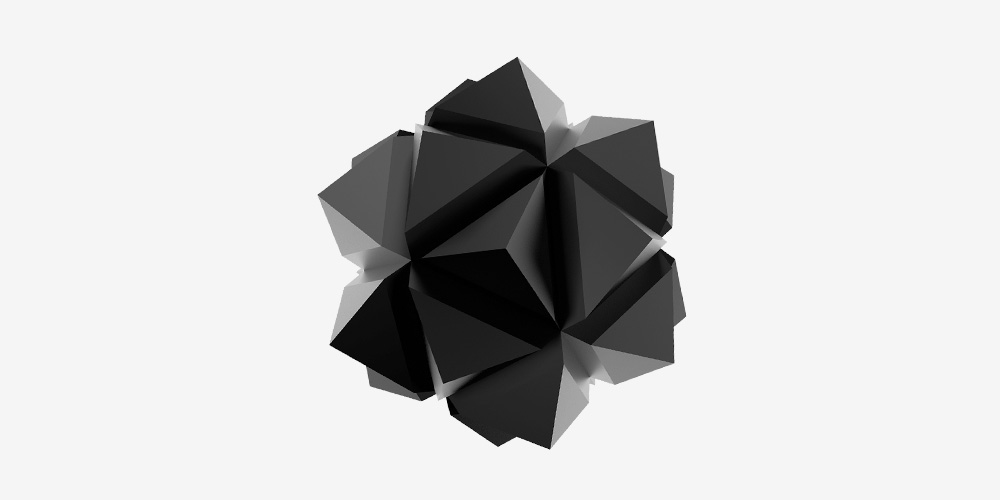We’ve all been there. You think you’ve created a flawless email and are ready to send it to the masses. You’ve double and triple-checked everything, but maybe you missed your morning cup of coffee, and after hitting send, you realize that something terrible has happened.
You’ve made a huge mistake, and now your credibility is on the line.
What should you do? Pack it up? Hang a big “Closed” sign on your door and call it a day? Has anyone ever failed as epically?
Relax, take a deep breath, and put down that sign. Larger companies have made mistakes in far worse ways and come out clean on the other side.
This article will illuminate some of the biggest email marketing bloopers of all time. We’re going to tell you what happened, how to avoid these pitfalls, and how you can keep your reputation intact.
Don’t wait for the muse. Apply this step-by-step method to write high-performing email campaigns in hours, not weeks.
Why email marketing mistakes happen
When you think about it, it’s no surprise that mistakes happen in email marketing. Making mistakes is part of being human.
But there are specific reasons for some email marketing mistakes that should be easily avoided. Things like:
- A lack of testing for typos, sensitive content, and links and promo codes. It’s essential to proofread thoroughly for spelling and grammar, check for sensitive content (tools like Writer and Grammarly have AI that can help with this), and test any links and promo codes to ensure that they work properly.
- Poor planning, procrastination, and rushing. Email is best done when you have plenty of time, a cool head, and fresh eyes.
- Overly-complex automation tools. Email automation tools can take your marketing strategy to the next level, but the flip side is their complexity. It can cause confusion, mistakes, and human errors if the person in charge of the automation tools doesn’t have a complete understanding of the platform.
Even with the best planning and preparation, some mistakes are unavoidable. This article will explore nine common email marketing mistakes and how to recover from them.
Let’s get to it.
9 big email marketing mistakes (and how to fix them)
Let’s begin with an easily made mistake that can make even seasoned marketers feel foolish.
#1. Sending to the wrong person/list/segment
You should always target your emails if you want to run effective campaigns. This is especially true if you have a large audience with multiple segments.
When sending a campaign, you’ll select the segments you wish to send it to. The key is to select carefully and not select the entire list — unless the campaign is truly meant for your entire mailing list.
Here’s an example of this mistake in action. Shutterfly planned an email outreach to congratulate customers who purchased birth announcement packages.
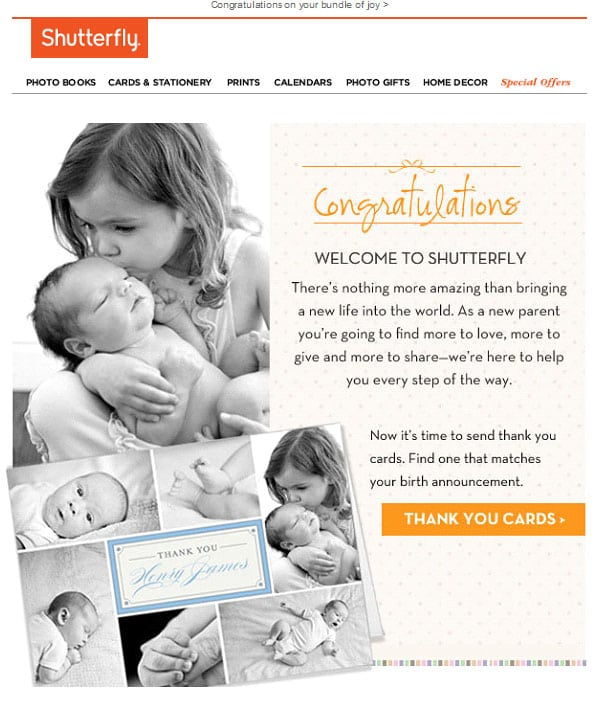
However, this message went out to everyone on Shutterfly’s massive list. That likely shocked the plethora of recipients who hadn’t just welcomed a new bundle of joy into their homes.
This error could have also been triggering for anyone who might have had a miscarriage or have trouble conceiving.
The company realized its mistake and quickly apologized by sending a follow-up email.
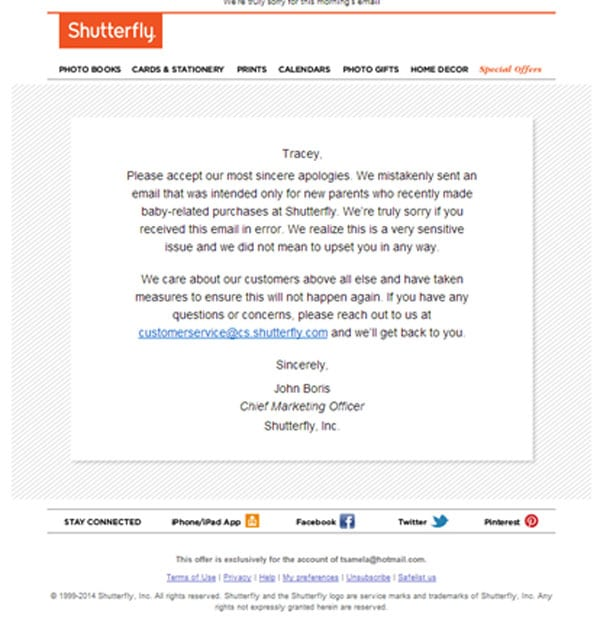
Shutterfly owned their mistake right away, taking responsibility for the error. The email even came from Shutterfly’s chief marketing officer, putting a name to the message. That gave the apology extra weight.
He also acknowledged how this could be a sore subject for some people, not shying away from the controversy. While mistakes can happen, utilizing expert campaign management services can help in crafting and segmenting communication more accurately. These services offer precision and insight to ensure that messages reach the right audience, mitigating potential missteps in the future.
#2. Accidental email blasting
Another common mistake is accidental email blasting — sending multiple emails in a short amount of time. For example, a company might accidentally send out an entire month’s email campaign in a day. That would flood the inboxes of customers and trigger spam filters everywhere.
The Body Shop made this mistake when sending out emails for its Breathe range marketing campaign. The email accidentally went out more than once, spamming users and creating an embarrassing issue.
Here’s the apology email they sent.
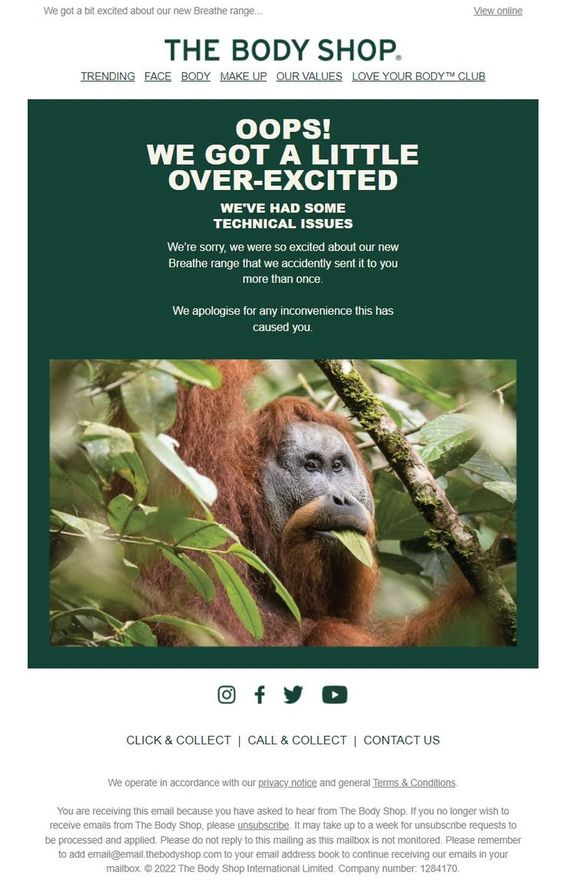
The company was humble about the incident and even made light of the situation. Everyone makes mistakes, so admitting that your business is fallible is an opportunity to humanize your brand.
#3. Forgetting to include a promo code
If you’re running a major promotion that requires a promo code or specific information, it’s usually a good idea to make sure you include that information.
After all, people need to be able to act and convert.
If you forget to include a promo code in an email for your big sale or marketing promotion, you’re cutting the legs off that campaign right away. The risk here is that a mistake of this magnitude makes you look incompetent or otherwise disorganized to customers. It can frustrate those recipients who have been waiting for this offer.
You could also forget to mention the special features of a product in an email marketing message. That can be a significant mistake with several implications. If you forget a vital piece of information like this, take a cue from Frenchie Pet Supply. It launched its major spring fling promotion with a major glitch that made the special pricing unavailable.
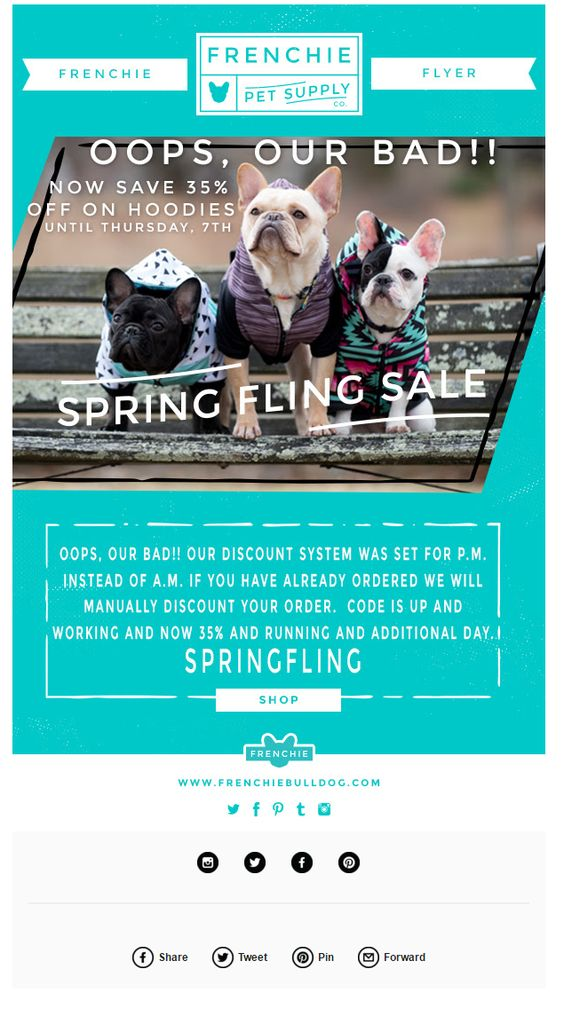
The company apologized, owned up to the mistake, and corrected the issue. It even said it would issue credits for anyone who made a full-priced purchase, and extended the offer to make up for its mistake.
#4. Linking to a site that crashes from overuse
Even worse than forgetting to include a link is including a link to a site that doesn’t work or has completely crashed.
When someone clicks on your link, and it takes them to a broken page, their trust in you can falter. Your customers might even think you’re trying to get their personal information.
At best, broken links show a lack of competency. If your site crashes from overuse, it shows that you didn’t prepare. It’s not inspiring anyone to trust you with their hard-earned money. Lilly Pulitzer’s Endless Summer Sale had this exact issue. Its site crashed because it couldn’t handle the volume of traffic it received. Once the site was back up, the company issued this message.
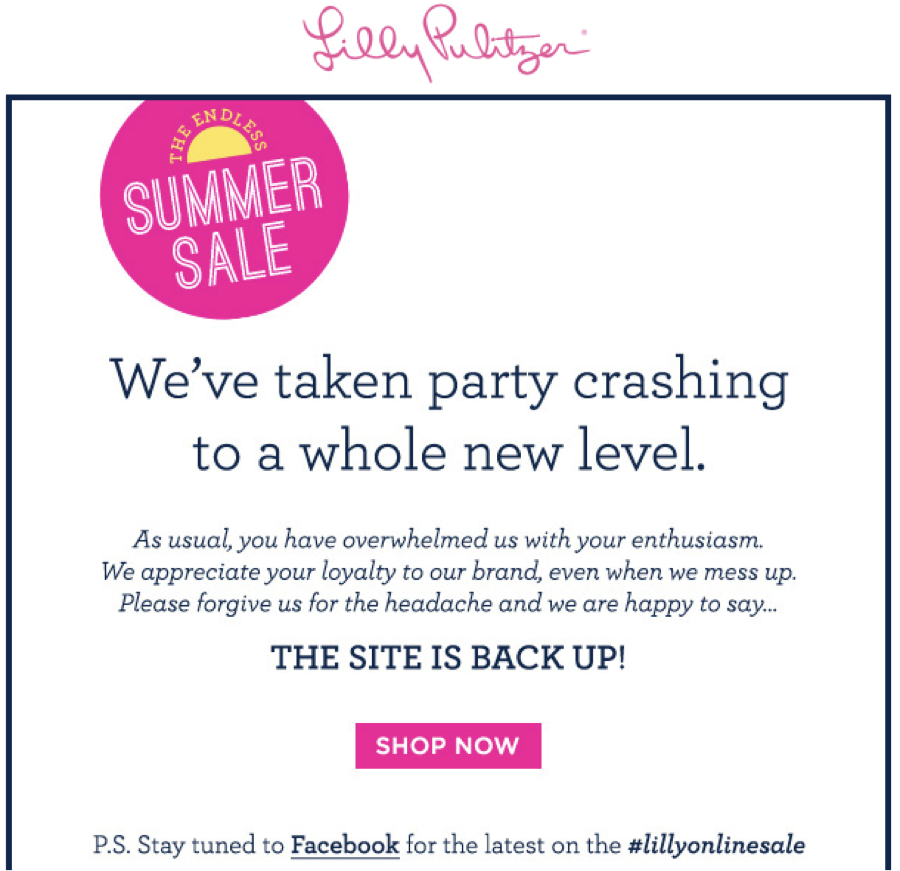
The company apologized, making light of the situation with a pun in the headline. It then thanks customers for such an enthusiastic response and lets them know that the site is back up.
It even provided a CTA “Shop Now” button to get people back into the sale.
Don’t wait for the muse. Apply this step-by-step method to write high-performing email campaigns in hours, not weeks.
#5. Wrong subject line
When you send out an email blast, pay careful attention to your subject line. If it doesn’t match the body copy, it creates a poor user experience filled with confusion and mistrust.
The body copy should be an extension of the hook, cementing your value proposition and improving your odds of conversion. But if you attach a wrong subject line to your email, you’ve just confused and frustrated your customer.
Here’s an example from the company VinoMofo. It sent out a product email with an old, outdated subject line.
Here’s their apology email.
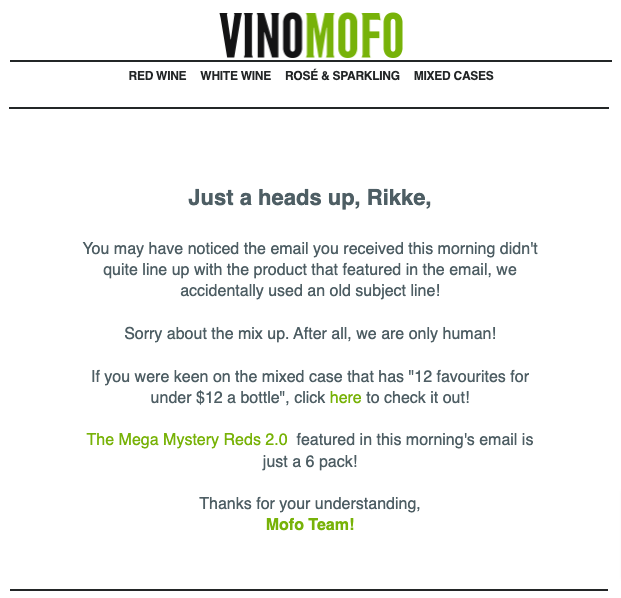
In the email, the VinoMofo team is apologetic and humble as it admits its mistake. It also provides the correct information with a link to the product hyped in the original subject line.
#6. Personalization errors
Personalization can be among the most powerful tools in the email marketing playbook. With personalization options, you can significantly improve your campaign’s response rates.
But what happens when your personalization efforts glitch? That happened when Drizly sent out an email addressed to “{name}.”
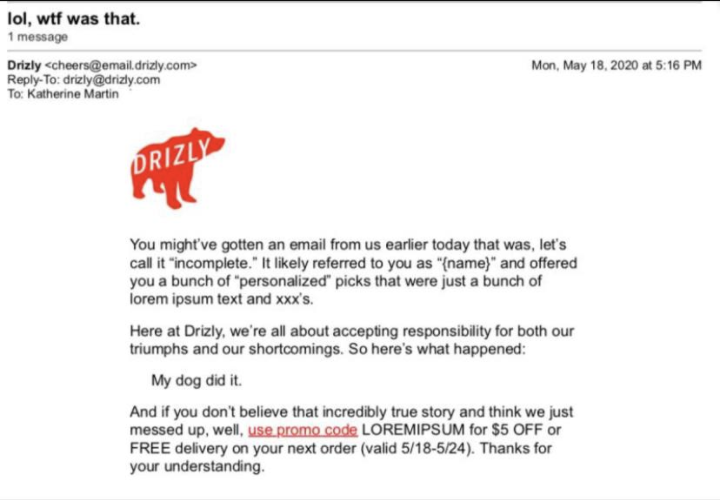
Here’s their follow-up email.
Drizly takes a humorous approach to its apology, with everything from the email subject line to the body eliciting smiles. It then closes with a special promo code that gives subscribers a discount as an apology.
#7. Including the wrong information
Your emails need to be factual if they’re going to be effective. Including inaccurate information on something as important as an event can be disastrous for your reputation.
This mistake can include incorrect details like providing the wrong address or the wrong date and time.
Of course, these mistakes happen to the best of us. Even to companies called “Really Good Emails.”
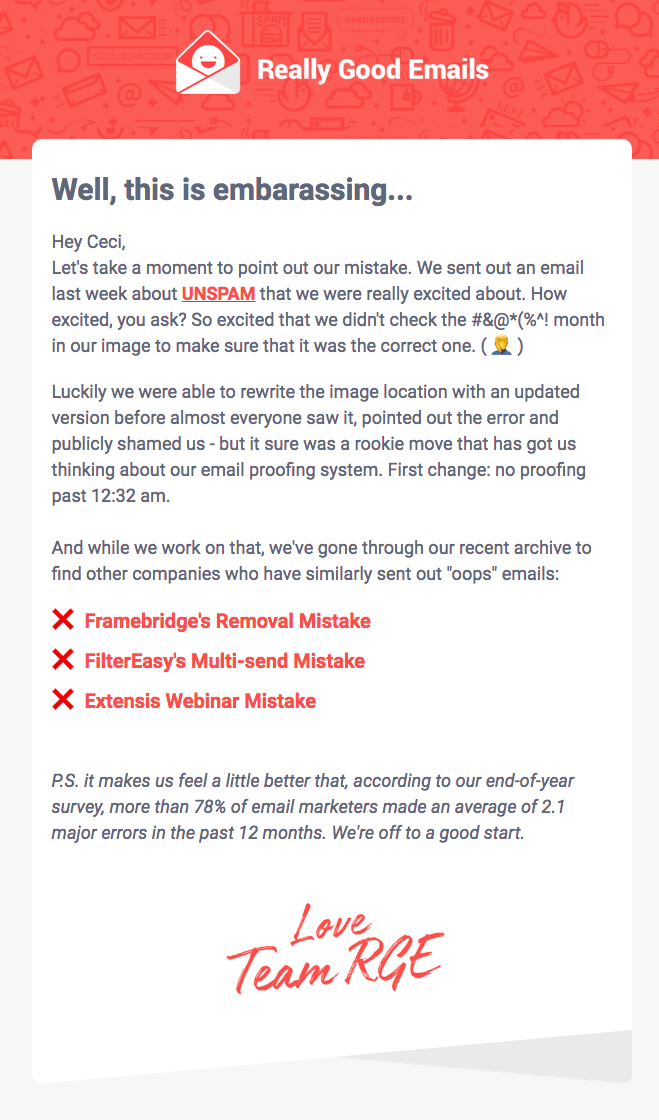
The team owns up to its mistake and promises it won’t happen again. This very complete apology endears the RGE team to the reader and earns forgiveness by the end. It even includes a statistic about how common it is for mistakes to make it into marketing messaging.
A frequent mistake is also sending emails with incorrect billing information. To avoid this error, you can use invoicing software that automates the process of making invoices and sending emails.
#8. Unfortunate typos
Whether texting or in an email, we’ve all made those horrifically embarrassing typos that change the entire meaning of your message.
The major issue with these email typos when they come from a business is that they can accidentally offend. Here are some humorous and entirely real typos that Twitter users have shared. Just imagine one of these making their way into your marketing emails.
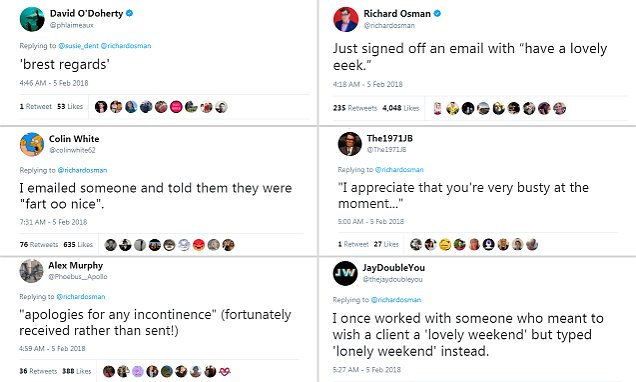
If you make one of these horrifying typos, make sure that you jump on it right away and create a sincere apology. This situation presents an opportunity to appeal to the humanity of your customers.
Embarrassing typos are something we can all relate to.
Just apologize in a humble way for any offense. If it was especially heinous, offer a discount or promo code as an apology.
#9. Accidental insensitivity
Even the best-intentioned promotional emails can fall victim to bad timing, making them devastating.
When crafting email campaigns, brands need to convey a genuine sense of understanding and support. They need to assure customers that they’re not alone in their struggles.
By incorporating empathy into their email marketing, brands can create a connection with their customers, establishing trust and fostering a sense of companionship. But sometimes, our emails can come back to bite us, especially when the unexpected happens.
Take this congratulatory email sent out by Adidas to customers who ran in the Boston Marathon.
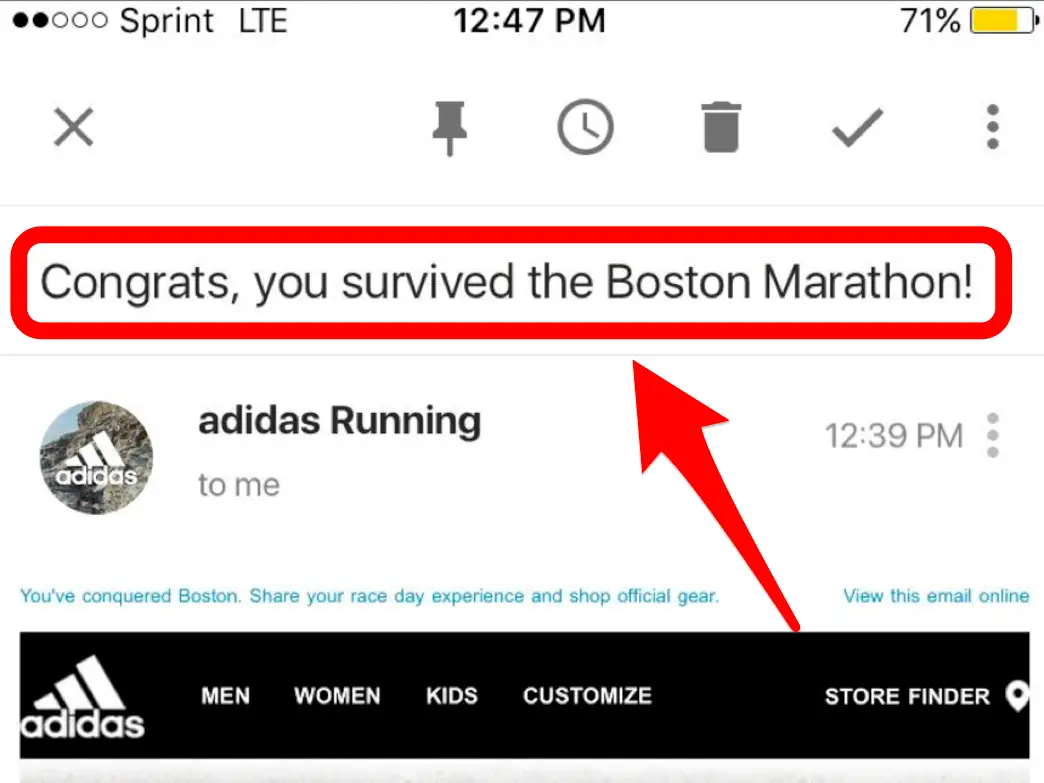
On the surface, this seems like a standard email, one that’s set up to go out automatically as part of a more extensive targeted campaign.
Unfortunately, this was in 2013 — the year of the Boston Marathon bombing tragedy. Two brothers rigged homemade explosives to detonate near the finish line, leading to the deaths of three people and injuring many more.
It’s easy to quickly see why Adidas’ wording rubbed some the wrong way. But the company was quick to issue a sincere apology, choosing to send it out publicly over social media. If there is a massive faux pas like this, however accidental, it’s best to apologize broadly so that the whole world can see your message.

Adidas was solemn in its apology. It went on to show genuine remorse and tried to offer some inspirational words. All-in-all, it was an effective apology for a massive mistake.
Follow-up email examples that fix mistakes
If you make any of the errors listed above, it’s important to apologize quickly. No matter what your mistake was, there are a few common elements that all apology emails should include.
- Use humility and own up to your mistakes. People understand that mistakes happen. They’re human too. Don’t try to pass the buck onto someone else or make excuses. You made this mistake, and it’s time to apologize.
- Be apologetic and make use of uplifting language. Try to inspire your customers through your apology.
- Use personalization to address the message directly to the customer when you can.
- Make note of what you learned from this mistake. Tell them how you’ll avoid making it again. This tactic shows that you’ve grown through the experience.
Finally, once you’ve made your apology, never fail in the same way twice. Having to apologize twice for the same thing is never a good look.
Here’s an example template to follow:
(Customer Name)
Recently, our team made a regrettable mistake when sending an email to our great customers on (subject of email).
Unfortunately, in that email, we (details of the mistake). I wanted to take this opportunity, on behalf of the entire (company name) team to sincerely apologize for this error.
We know that something like this can (specific ways that your mistake can impact customers). For that, we’re truly sorry and we commit to doing better for you in the future. Through this experience, our team has (detail what you learned). And because of that, we’ve altered our process to (details on how you’re avoiding this mistake in the future).
Again, please accept our deepest apology and our commitment to better ourselves and (company name) in the future as part of our never ending quest to serve you.
(If appropriate, include a special offer or promo code here).
Thank you for your time,
(Signature)
Now that you know better, start doing better
As an email marketer, you’ll make mistakes — it’s inevitable in this business. But what matters most is how you respond to those mistakes and adapt to guarantee you never make the same mistake twice.
By learning from the examples listed above, you can avoid embarrassing or disastrous email marketing mistakes in the future. You’ll then have a chance to present a more polished product to your audience.
Don’t miss out on new articles. Subscribe to our newsletter and get your monthly dose of SaaS email marketing insights.


